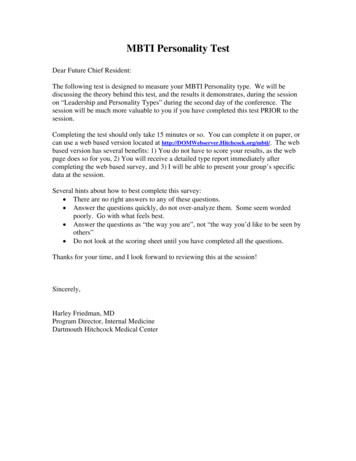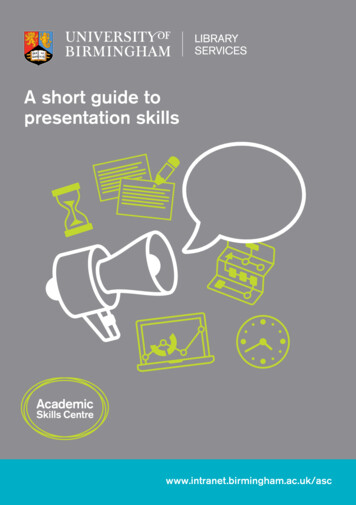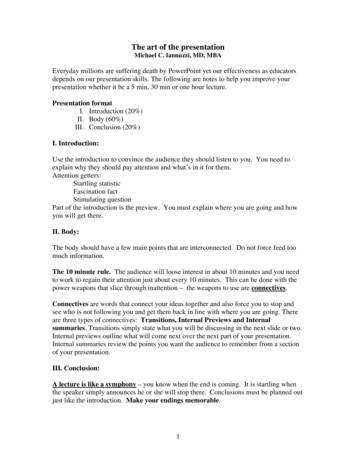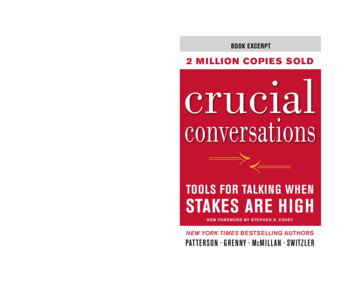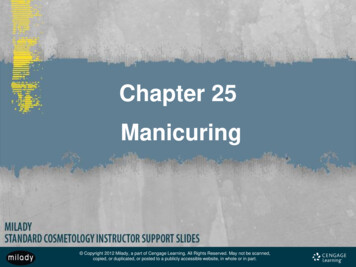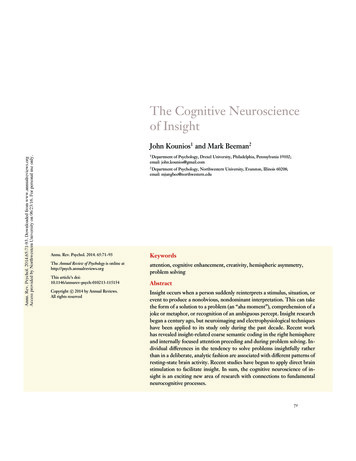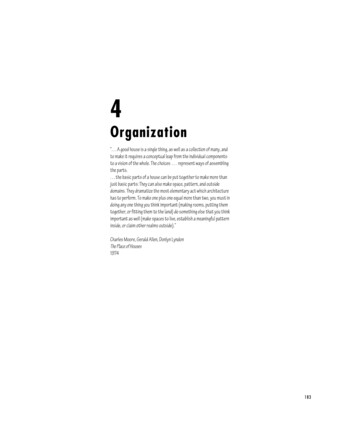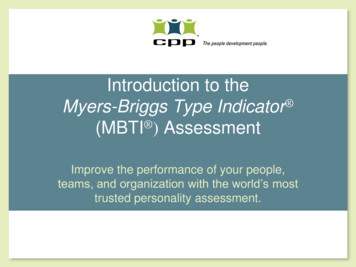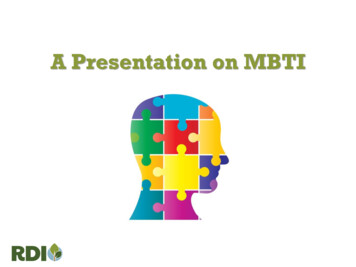
Transcription
A Presentation on MBTI
Carl G. JungCarl Gustav Jung(1875–1961), a Swisspsychiatrist, developeda theory of personality:Differences between peopleare not random. Instead theyform patterns—types.Psychological Types(published 1921, translatedinto English 1923)
Katharine C. BriggsKatharine C. Briggs(1875–1968), an American, readJung’s Psychological Types in1923.She spent the next 20 yearsstudying, developing, andapplying Jung’s theory.
Isabel Briggs MyersIsabel Briggs Myers(1897–1980) developed Jung’stheory in partnership withBriggs.Beginning in 1943, shedeveloped questions thatbecame the Myers-Briggs TypeIndicator instrument.
Jung’s Personality Theory Every person carries out two kinds of mentalprocesses:1. We take in information2. Then we make decisions about the information Everyone has preferred ways of using thesemental processes
Jung’s Personality TheoryJung observed that we all live in two worlds:1.The outer world of things, people, andeventsand2.The inner world of our own thoughts,feelings, and reflections
Jung’s Personality Theory Each person has a preference for either theouter world or the inner world
Jung’s Personality Theory Jung believed that preferences are innate—“inborn predispositions” He also recognized that they are shaped byenvironmental influences, such as family,culture, and educationNatureMBTI instrument vs.NurtureEnvironment
The MBTI Dichotomies The MBTI instrument indicates preferences on four pairsof opposites, called dichotomies: ExtraversionEorISensingSorN IntuitionThinkingTorF FeelingJudgingJorP PerceivingIntroversion
MBTI Theory Four pairs of opposites—like our right andleft hands. We all use both sides of eachpair, but one is our natural preference. The MBTI instrument is designed toindicate those inborn preferences. The MBTI instrument is not designed tomeasure skills or effects of environment.
Extraversion (E) or Introversion (I)Where we focus ourattention and get energySource: Introduction to Type (6th ed.), I. B. Myers, p. 9.
E–I DifferencesPeople who prefer Extraversion: Direct their energy and attention outward Focus on the outer world of people and activityPeople who prefer Introversion: Direct their energy and attention inward Focus on their inner world of ideas and experiencesWe all use both preferences, but usuallynot with equal comfort.Source: Introduction to Type (6th ed.), I. B. Myers, p. 9.
Key Words Associated with PrivacyConcentrationFewQuietThink-Do-Think
We Have a PreferenceWe all do Extraverted and Introverted things.But we usually do not do themwith equal comfort.Most of us have a preference for oneor the other.
Sensing (S) or Intuition (N)The way we take ininformation and the kind ofinformation we like and trustSource: Introduction to Type (6th ed.), I. B. Myers, p. 9.
S–N DifferencesPeople who prefer Sensing: Focus on present realities, verifiable facts, and experiencePeople who prefer Intuition: Focus on future possibilities, the big picture, and insightsWe all use both ways of perceiving, but wetypically prefer and trust one of them more.Source: Introduction to Type (6th ed.), I. B. Myers, p. 9.
Key Words Associated with icalWhat reticalWhat could be
We Have a PreferenceWe all use Sensing and Intuition when making ourobservations about the world.But we usually do not use themwith equal trust.Most of us have a preference for oneor the other.
Thinking (T) or Feeling (F)The way we make decisionsSource: Introduction to Type (6th ed.), I. B. Myers, p. 10.
T–F DifferencesPeople who prefer Thinking: Make their decisions based on impersonal, objective logicPeople who prefer Feeling: Make their decisions based on personal priorities andrelationshipsBoth processes are rational and we use both,but usually not with equal ease.Source: Introduction to Type (6th ed.), I. B. Myers, p. 10.
How People Make DecisionsPeople who preferThinking (T)People who prefer Feeling(F) Step back to get an objectiveview Analyze Use cause-and-effectreasoning Solve problems with logic Step in to identify with thoseinvolved Empathize Are guided by personal andgroup values Assess impacts of decisionson peopleSource: Introduction to Type (6th ed.), I. B. Myers, p. 10.
Key Words Associated with alyzeFirm but rstandMerciful
Judging (J) or Perceiving (P)Our attitude toward theexternal world and how weorient ourselves to itSource: Introduction to Type (6th ed.), I. B. Myers, p. 10.
J–P DifferencesPeople who prefer Judging: Want the external world to be organized and orderly Look at the world and see decisions that need to be madePeople who prefer Perceiving: Seek to experience the world, not organize it Look at the world and see options that need to be exploredWe all use both attitudes, but usuallynot with equal comfort.Source: Introduction to Type (6th ed.), I. B. Myers, p. 10.
How People Approach LifePeople who preferJudging (J)People who preferPerceiving (P) OrganizedSystematicMethodicalMake short- and long-termplans, and then follow themAdaptable and curiousCasualOpen-endedAdjust flexibly to newinformation and changesSource: Introduction to Type (6th ed.), I. B. Myers, p. 10.
How People Approach LifePeople who preferJudging (J)People who preferPerceiving (P) Like to have thingsdecided Resist reopening decisions Try to avoid last-minutestresses Like to explore options Resist cutting off options,making decisions too soon Feel energized by last-minutepressuresSource: Introduction to Type (6th ed.), I. B. Myers, p. 10.
Key Words Associated with aterOptionsSpontaneousWait
Personality TypeWhen combined, your preferences indicateyour personality type.
16 Personality Types
E/I Preference ExerciseWhat do you admire aboutintroverts/extroverts?What baffles you about introverts/extroverts?What do you want introverts/extrovertsto know about you?
Resources: Select BooksPeople Patterns – a modern guide tothe four temperamentsby Stephen Montgomery Ph.D.NT – Rational SJ - GuardianNF – Idealist SP - Artisan
MBTI Type Distribution(National Representative Sample)Total PopulationfemalemaleTotal PopulationfemalemaleTotal PopulationfemalemaleTotal .31.74.8ENTP3.22.44.9ENTJ1.80.92.7
Carl Gustav Jung (1875–1961), a Swiss psychiatrist, developed a theory of personality: Differences between people are not random. Instead they form patterns—types. Psychological Types (published 1921, translated into Eng
